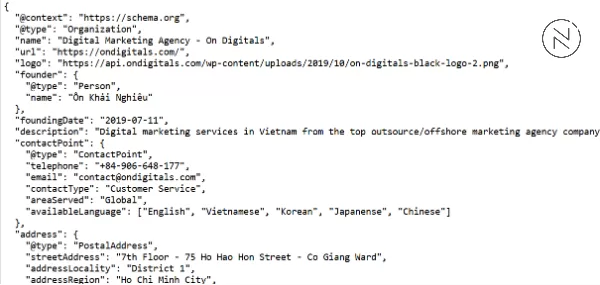Insights
Mastering Structured Data for SEO and GEO In 2025
On Digitals
08/10/2025
42
Structured Data for SEO and GEO is the essential strategy in 2025. If we just rely on plain text content, your website will certainly never show up in top search results.
The synergy between Google’s sophisticated search algorithm and the demanding Generative Engineering Optimization (GEO) systems requires much more from your data structure.
Structured data for SEO and GEO, which is the common language that helps machines truly understand your content, making it vital for visibility and innovation. Let’s dive into the details with On Digitals.
Why is Structured Data Important for SEO and GEO?
Structured data for SEO and GEO is more than just an optimization tool; it is a strategic asset that simultaneously addresses the two biggest challenges of the digital age: search visibility and AI-driven product innovation. Understanding how structured data operates in both arenas is the key to winning in 2025.

Structured Data for SEO and GEO in 2025
Structured Data for SEO: Winning the SERP Real Estate
Structured data serving the purpose of structured data for seo is not merely about adding code; it’s the most effective data communication strategy with Google, helping you gain an advantage on the Search Engine Results Page (SERP) and driving users to click on your site.
- Maximize SERP Real Estate: Use structured data to convert regular search results into Rich Snippets (e.g., direct answer blocks from FAQPage, one of the most common structured data examples). This action allows you to dominate a large space on the SERP, boosting visibility and pushing competitors down.
- Boost Click-through Rate (CTR): Structured data provides “social proof” directly on the SERP. For instance, the Review Schema displays eye-catching golden star ratings, serving as a strong persuasive factor that immediately boosts your CTR. Similarly, the Product Schema shows pricing and availability, attracting users with high purchase intent.
- Establish Authority (Reinforce E-E-A-T): Accurate implementation of specialized Schemas like TechArticle or Organization helps Google confirm your expertise and authority. Structured data provides clear evidence, directly strengthening the website’s E-E-A-T (Experience, Expertise, Authoritativeness, Trustworthiness) score.
Structured Data for Generative Engineering Optimization
Currently, search methods are becoming increasingly complex and diverse, making chasing traditional keywords more difficult. Clearly, contextual relevance is crucial.
Therefore, structured data for SEO and GEO is even more essential, as it provides search engines and AI systems with accurate information about your content’s context

Structured Data enhancing GEO and AI-driven content understanding
For Generative Engineering Optimization (GEO), the role of structured data for geo expands further: it helps AI systems better understand not only your web content but also your product data. Choosing the correct structured data format is critical.
Here are 5 key benefits of structured data for GEO, helping improve product innovation efficiency:
- Provide Clean Data for AI: Structured data (specifically the Dataset and QuantitativeValue Schemas, critical structured data examples for engineering) offers a perfectly categorized and quantified source of technical data. This is the ideal, clean “raw material” to feed and train GEO algorithms.
- Support Smart Feedback Loops: Structured customer feedback data (via the Review Schema) can be fed back into the GEO system to refine optimization goals, ensuring AI’s new designs closely meet market demands.
- Enhance Data Discoverability: Researchers and partners can easily search for and access your technical datasets via Schema, fostering collaboration and innovation within the industry.
- Facilitate Automated Design Cycles: Structured Data allows GEO systems to automatically tag and publish newly optimized designs directly to the web as Structured Data. This significantly shortens the time-to-market from concept to launch.
- Reduce Data Pre-processing Costs: Instead of using complex algorithms to scrape and clean data from unstructured web pages, GEO can directly consume clean Schema data. This drastically saves time and costs associated with initial data preparation.
How to add structured data for SEO and GEO to your website?
You need to thoroughly research structured data before deploying it on your website because accurate application isn’t easy. A small mistake can lead Google to ignore the entire code block. But remember, the main purpose of structured data is to help search engines understand your page content better, thereby improving visibility.
Choosing the right format is the first step toward success with structured data for Seo and Geo. Here are the best practices for applying structured data to your website:
Common Deployment Methods
JSON-LD (JavaScript Object Notation for Linked Data)
Mechanism: The code is written as a standalone JSON block, not directly attached to HTML tags. This block is typically placed within the <script type=”application/ld+json”> tags in the <head> (or sometimes the <body>) section of the page.

JSON-LD as a common method for deploying structured data.
Key Advantages:
- Easy to Deploy and Manage: Because the code is completely separate from the HTML content, developers can easily inject it via Google Tag Manager (GTM) or content management systems (CMS) without modifying the page structure.
- Google Recommended: This is the format most preferred by Google due to its flexibility and high readability, making it ideal for structured data for seo.
- GEO Suitability: It is ideal for injecting complex Schemas like Dataset because it allows for the clean declaration of a large amount of structured data, strongly supporting Generative Engineering Optimization (GEO) efforts.
Drawbacks: If deployed using GTM, Google may have to wait for JavaScript execution to render the code.
Microdata
Mechanism: The code is embedded directly into existing HTML tags using attributes (itemscope, itemtype, itemprop). The structured data code blends with the visible content.
Advantages: Easy to tag specific content elements on the page.
Drawbacks:
- Difficult to Maintain: If you change your HTML structure (e.g., moving a text block to a different <div> tag), you must check and modify all Microdata attributes. This hinders the flexibility required for both SEO and GEO.
- High Error Potential: Easily breaks the page’s underlying HTML code.
- Less favored by Google than JSON-LD for new projects.
RDFa (Resource Description Framework in Attributes)
Mechanism: Similar to Microdata, RDFa also embeds code into HTML tags using attributes like vocab, typeof, and property.
Advantages: More flexible than Microdata in terms of vocabulary extension.
Drawbacks:
- Complex Syntax: Difficult to understand and accurately implement for beginners.
- Least Common: Very few automation tools support RDFa compared to JSON-LD, making it inefficient for a modern structured data for seo and geo strategy.
Steps to Add Structured Data to Your Website for the Best Results
The process of deploying Structured Data requires accuracy. To ensure your success with structured data for SEO and GEO, follow this 4-step procedure:
1. Identify Schema Needs
For your website, it’s mandatory for the site owner to know the core content and goal of each page. You need to determine which Schema best describes that information so Google can understand the context:
- SEO Examples:
-
-
- An e-commerce page needs Product and Offer (to display price and inventory status).
- A QA blog post needs FAQPage (to create the FAQ block on the SERP).
-
- GEO/Technical Examples:
-
- A deep-dive technical article needs TechArticle and Dataset (to provide clean data for AI/GEO models).
2. Generate Code and Prepare Data
This is the stage where information is transformed into JSON-LD code, a crucial step in implementing structured data for SEO and GEO. In this step, you can reference Schema.org directly to customize the code for your needs.
While custom coding does require programming experience, it provides great flexibility for your website and allows you the freedom to set up complex Schemas

Example of On Digitals schema in JSON-LD format for structured data
However, to save time for more common Schemas, there are also several code generation tools available that you can use, such as Google Structured Data Markup Helper, Google Data Highlighter… or popular plugins from WordPress like Yoast SEO and Schema App.
3. Markup and Deploy the Code to the Website
While code preparation can be complex, deploying structured data for SEO and GEO onto the website is quite easy. If you use support tools or a Content Management System (CMS) with built-in integration, this stage will be relatively smooth.
However, because these tools often lack flexibility or do not include all the specialized Schema you might need, modern websites prioritize the JSON-LD format.

Deploying structured data with JSON-LD for modern websites
You simply need to inject the created JSON-LD code block into the <head> section of the page to complete the deployment process.
4. Test Your Structured Data
This is the most crucial step to ensure your structured data for SEO and GEO efforts are not wasted. Testing here is not just about checking if your schemas are working, but also about seeing how the structured data will appear when Google displays Rich Snippets.
You can reference several tools to check your scripts, such as:
- Rich Results Test: This tool checks your URL or code snippet to determine which Rich Snippets (rich results) are eligible to display. It reports not only syntax errors but also missing required properties.
- Schema Markup Validator: This tool checks the syntactic validity of your Schema code (JSON-LD, Microdata, RDFa). It confirms whether you have used the correct Schema.org vocabulary.
- URL Inspection Tool in Google Search Console: After deploying the code, you use this tool to request immediate indexing of the page and see how Google read and understood your Schema on the published page.
FAQ: Structured Data for SEO and GEO: The Dual Strategy To Dominate Search And Innovation In 2025
1. What is the difference between structured data for SEO and GEO in 2025?
Structured data for SEO focuses on helping Google understand web content to improve rankings and display rich snippets.
Structured data for GEO supports Generative Engineering Optimization by providing clean, machine-readable data for AI systems, boosting product innovation and automation in 2025.
2. How does structured data improve search rankings and visibility?
Structured data enhances SERP visibility by enabling rich snippets such as reviews, FAQs, and product details.
These snippets increase click-through rates, highlight authority, and push competitors lower on search results. In 2025, structured data is essential for both higher rankings and improved user engagement.
3. Which structured data format is best for SEO and GEO: JSON-LD, Microdata, or RDFa?
Structured data for SEO and GEO in 2025 is best implemented using JSON-LD, the most effective structured data format.
It is Google-recommended, easy to deploy, and ideal for complex schemas like Dataset. In contrast, Microdata and RDFa are less flexible, harder to maintain, and not favored for modern SEO strategies
4. Can structured data examples like FAQPage and Product Schema boost CTR in 2025?
Yes. Structured data for SEO and GEO examples like FAQPage, Product, and Review Schema directly impact CTR.
They display FAQs, star ratings, pricing, and availability in search results, providing social proof and attracting high-intent users. In 2025, these schemas are critical for driving clicks and conversions.
5. How do I add and test structured data on my website for SEO and GEO optimization?
To add structured data for SEO and GEO, generate JSON-LD code for the right schema, inject it into your website’s head, and test it. Use Google’s Rich Results Test, Schema Markup Validator, and Search Console to confirm correct implementation and eligibility for rich snippets in 2025

Adding and testing Structured Data for SEO and GEO optimization.
Structured Data for SEO and GEO with On Digitals
In 2025, mastering structured data for SEO and GEO is no longer optional, it is the cornerstone of online visibility and AI-driven innovation. From dominating SERP real estate with rich snippets to powering GEO systems with clean, contextual data, structured data ensures your business stays competitive in the evolving digital landscape.
To fully unlock this potential, partnering with experts makes all the difference. On Digitals is a leading digital marketing agency that helps businesses implement structured data strategies, optimize SEO, and leverage GEO for innovation. With On Digitals, you gain not just technical support but also a trusted partner committed to your growth and success in 2025.
NEWEST POSTS
- YouTube Growth Hacks Tips You Need to Know In 2025
- YouTube SEO Checklist 2025: Complete Guide to Boost Video Rankings
- YouTube Marketing Strategy: How to Build a Winning Presence in Vietnam (2025 Edition)
- 7 Tips To Repurpose Video Content Like A Pro In 2025
- Mastering TikTok SEO in 2025: Stay Visible With These Tips
Read more
